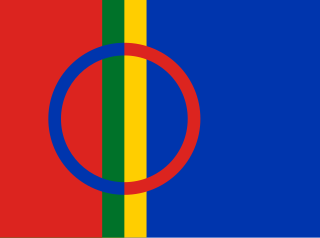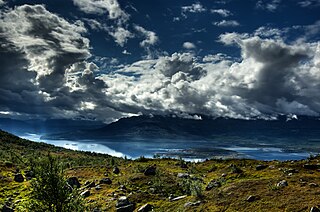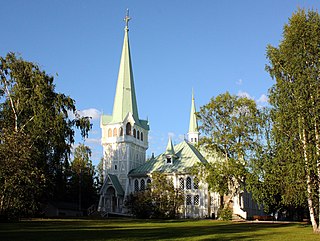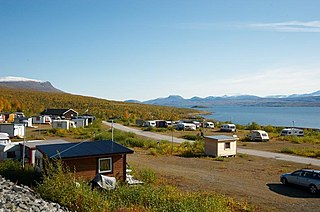
Sápmi is the cultural region traditionally inhabited by the Sámi people. Sápmi includes the northern parts of Fennoscandia, also known as the "Cap of the North".

Norrbotten County is the northernmost county or län of Sweden. It is also the largest county by land area, almost a quarter of Sweden's total area. It shares borders with Västerbotten County to the southwest, the Gulf of Bothnia to the southeast, the counties of Nordland and Troms in Norway to the northwest, and Lapland Province in Finland to the northeast.

Arjeplog Municipality is a municipality in Norrbotten County in northern Sweden. Its seat is located in Arjeplog.

Midnight sun, also known as polar day, is a natural phenomenon that occurs in the summer months in places north of the Arctic Circle or south of the Antarctic Circle, when the Sun remains visible at the local midnight. When midnight sun is seen in the Arctic, the Sun appears to move from left to right. In Antarctica, the equivalent apparent motion is from right to left. This occurs at latitudes ranging from approximately 65°44' to exactly 90° north or south, and does not stop exactly at the Arctic Circle or the Antarctic Circle, due to refraction.
In 1999, the Minority Language Committee of Sweden formally declared five official minority languages: Finnish, Sámi languages, Romani, Yiddish, and Meänkieli.

Haparanda is a locality and the seat of Haparanda Municipality in Norrbotten County, Sweden. It is adjacent to Tornio, Finland. Haparanda has a population of 9,166 inhabitants (2024).

Överkalix is a locality and the seat of Överkalix Municipality in Norrbotten County, Sweden with 975 inhabitants in 2010.

Lycksele is a locality and the seat of Lycksele Municipality in Västerbotten County, province of Lapland, Sweden with 8,513 inhabitants in 2010.

Jokkmokk is a locality and the seat of Jokkmokk Municipality in Norrbotten County, province of Lapland, Sweden, with 2,786 inhabitants in 2010. The Lule Sami name of the place means "River's Curve," due to the meandering river that runs through it. As in other towns in Lapland, the Swedish language is dominant at an official level in Jokkmokk in modern times. The settlement is just north of the Arctic Circle. Talvatissjön is located at the southern part of Jokkmokk.

Gällivare is a locality and the seat of Gällivare Municipality in Norrbotten County, province of Lapland, Sweden with 8,449 inhabitants in 2010. The town was founded in the 17th century. Together with nearby towns Malmberget and Koskullskulle it forms a conurbation with some 15,000 inhabitants. This conurbation is the second northernmost significant urban area of Sweden after Kiruna.

Arvidsjaur is a locality and the seat of Arvidsjaur Municipality in Norrbotten County, province of Lapland, Sweden with 4,635 inhabitants in 2010.

Abisko is a village in Sápmi (Lapland), in northern Sweden, roughly 200 km north of the Arctic Circle, and near Abisko National Park, located 4 km west of the village. It had 85 inhabitants as of 2005.

Lapland, also known by its Swedish name Lappland, is a province in northernmost Sweden. It borders the Swedish provinces of Jämtland, Ångermanland, Västerbotten, and Norrbotten, as well as Norway and Finland. Nearly a quarter of Sweden's land area is in Lappland.

Karesuando is the northernmost locality in Sweden. It is situated in Kiruna Municipality, Norrbotten County, Sweden, with 303 inhabitants in 2010 and 350 in 2011.

Nikkaluokta is a Swedish Sami village in Norrbotten County. The village belongs to Gällivare Municipality, bordering Kiruna Municipality, the closest urban area some 60 kilometers away. In its vicinity lie the areas of two Sami communities, Laevas and Girjas, who still herd semi-domesticated reindeer in the region.
Sámi schools, which were referred to as Nomad schools or Lapp schools before 1977, are a type of school in Sweden that runs parallel to the standard primary school system. Sámi schools are part of the Swedish public school system, and as such are governed by the same curriculum that primary schools are. Sámi schools are state-owned educational institutions that are open to all children whose parents identify as Sámi. Each school has its own dormitory that many students live in for large parts of the academic year due to the long distances in the north of Sweden.

Ritsem is a village in the Gällivare Municipality, Norrbotten County, Sweden. It is located in the Stora Sjöfallet National Park. The area falls within the Swedish Lapland, and is home to the Sámi people during the reindeer migration. The town contains a 320 megawatt hydroelectric power plant, which sits inside a 16 km artificial tunnel connecting lake Sitasjaure to the Akkajaure reservoir. There is also a mountain cabin and caravan camp run by the Swedish Tourist Association.

The south of Sweden has a temperate climate, despite its northern latitude, with largely four distinct seasons and mild temperatures throughout the year. The winter in the far south is usually weak and is manifested only through some shorter periods with snow and sub-zero temperatures, autumn may well turn into spring there, without a distinct period of winter. The northern parts of the country have a subarctic climate while the central parts have a humid continental climate. The coastal south can be defined as having either a humid continental climate using the 0 °C isotherm, or an oceanic climate using the –3 °C isotherm.

Tjeggelvas is a lake in northern Sweden. It is located in Arjeplog Municipality in the province of Swedish Lapland, and administratively of Norrbotten County and is part of the Pite River catchment area. Tjeggelvashas is on the western edge of the Scandinavian Mountains, with a high surface elevation of 450 m (1,480 ft). The nearest settlements, Jäkkvik and Arjeplog, are to the south, along the shores of the larger lake Hornavan.

Sädvvájávrre, or Sädvajaure, is a lake in Arjeplog Municipality in the province of Lapland, which is part of the main catchment area of the Skellefte River. The lake is 120 meters deep, covers an area of 40.1 square kilometers and has an elevation of 466.6 meters above sea level. Sädvvájávrre is located in the upper part of the Skellefte River and is drained by the same river. During test fishing, lake trout, arctic char, splejk (hybrid), and brown trout have been caught in the lake.





















